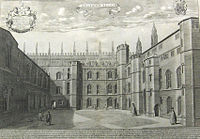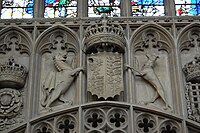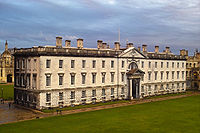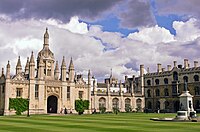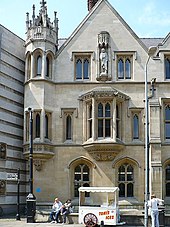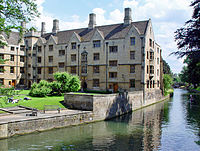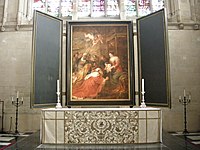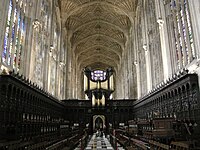King's College, Cambridge
| King's College Latin: Collegium Regale beate Marie et sancti Nicholai Cantebrigie
| |||||||||||
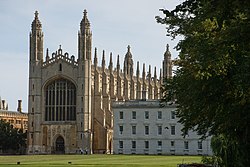 King's College Chapel and the Gibbs' Building | |||||||||||
|---|---|---|---|---|---|---|---|---|---|---|---|
| Provost: | Gillian Tett | ||||||||||
| Website: | kings.cam.ac.uk | ||||||||||
| |||||||||||
| Location | |||||||||||
| Grid reference: | TL44715834 | ||||||||||
| Location: | 52°12’15"N, 0°6’58"E | ||||||||||
The King's College of Our Lady and Saint Nicholas in Cambridge, also known as simply King's College is a constituent college of the University of Cambridge.[1] This college lies beside the River Cam and faces out onto King's Parade in the centre of the city.
King's was founded in 1441 by King Henry VI soon after he had founded its sister institution at Eton College. Initially, King's accepted only students from Eton College. However, the king's plans for King's College were disrupted by the Wars of the Roses and the resultant scarcity of funds, and then his eventual deposition. Little progress was made on the project until 1508, when King Henry VII began to take an interest in the college, probably as a political move to legitimise his new position. The building of the college's chapel, begun in 1446, was finished in 1544 during the reign of Henry VIII.
King's College Chapel is regarded as one of the finest examples of late Gothic architecture. It has the world's largest fan vault, while its stained-glass windows and wooden chancel screen are considered some of the finest from their era. The building is seen as emblematic of Cambridge. It houses the Choir of King's College, Cambridge. Every year on Christmas Eve, the Festival of Nine Lessons and Carols (a service originally devised for Truro Cathedral by Edward White Benson in 1880, adapted by the college dean Eric Milner-White in 1918) is broadcast from the chapel to millions of listeners worldwide.[2][3]
Contents
History
Foundation
On 12 February 1441, King Henry VI issued letters patent founding a college at Cambridge for a rector and 12 poor scholars.[4] This college was to be named after St Nicholas upon whose feast day Henry had been born.[5] The first stone of the college's Old Court was laid by the King on Passion Sunday, 2 April 1441 on a site which lies directly north of the modern college and which was formerly a garden belonging to Trinity Hall. William Millington, a fellow of Clare College (then called Clare Hall) was installed as the rector.[6]
Henry directed the publication of the college's first governing statutes in 1443. His original modest plan for the college was abandoned, and provision was instead made for a community of 70 fellows and scholars headed by a provost. Henry had belatedly learned of William of Wykeham's 1379 twin foundations of New College, Oxford and Winchester College, and wanted his own achievements to surpass those of Wykeham. The King had founded Eton College on 11 October 1440 but, up until 1443, King's and Eton had been unconnected.[7] However, that year the relationship between the two was remodelled upon Wykeham's successful institutions and the original sizes of the colleges scaled up to surpass Wykeham's. A second royal charter which re-founded the now much larger King's College was issued on 12 July 1443. On 1 September 1444, the Provosts of King's and Eton and the Wardens of Winchester and New College formally signed the Amicabilis Concordia ("friendly agreement") in which they bound their colleges to support one another legally and financially.
Members of King's were to be recruited entirely from Eton. Each year, the provost and two fellows travelled to Eton to impartially select the worthiest boys to fill any vacancies at the college, always maintaining the total number of scholars and fellows at exactly 70.[8] Membership of King's was a vocation for life. Scholars were eligible for election to the fellowship after three years of probation, irrespective of whether they had achieved a degree or not. Undergraduates at King's – unlike those from other colleges – did not have to pass university examinations to achieve their BA degree and instead had only to satisfy the college. Every fellow was to study theology, save for two who were to study astronomy, two civil law, four canon law, and two medicine; all fellows save those studying secular subjects were obliged to take Holy Orders and become priests, on pain of expulsion.[9][10][4] In 1445, a Papal Bull from Eugenius IV exempted college members from parish duties, and in 1457, an agreement between the provost and chancellor of the university limited the chancellor's authority and gave the college full jurisdiction over internal matters.
Henry VI, Henry VII and Henry VIII
The original plans for Old Court were too small comfortably to accommodate the larger college community of the second foundation, and so in 1443 Henry VI began to purchase the land upon which the modern college now stands. The gateway and south range of Old Court had already been built, but the rest was completed in a temporary fashion to serve until the new court was ready. The new college site was itself left unfinished and the "temporary" Old Court buildings, arranged to accommodate 70, served as the permanent residential fabric of the college until the beginning of the 19th century.[11][12] Henry's grand design for the new college buildings survives in the 1448 Founder's Will, which describes his vision in detail. The new college site was to be centred on a great courtyard, bordered on all sides by adjoining buildings: a chapel to the north; accommodation and the entrance gate to the east; further accommodation and the provost's lodge to the south; and a library, hall and buttery to the west. Behind the hall and buttery was to be another courtyard, and behind the library a cloistered cemetery including a magnificent bell tower.
The first stone of the chapel was laid by the King on St James's Day, 25 July 1446. The King encouraged support for the college. In 1448, John Conches, former prior of Wootton Wawen gave the priory's lands to "John Chedworth provost of the king's college of St. Mary and St. Nicholas Cantebrigge and the scholars thereof, and to their successors."[13] Within a decade Henry's engagement in the Wars of the Roses meant that funds began to dry up. By the time of Henry's deposition in 1461, the chapel walls had been raised 60 feet high at the east end but only 8 feet at the west; a building line which can still be seen today as the boundary between the lighter stone below and the darker above. Work proceeded sporadically until a generation later in 1508 when the Founder's nephew, Henry VII, was prevailed upon to finish the shell of the building. The interior had to wait a further generation until completion by 1544 with the aid of Henry VIII. The chapel was the only part of Henry VI's Founder's Will to be realised.
It has been speculated that the choice of the college as a beneficiary by the two later Henrys was a political one, with Henry VII in particular concerned to legitimate a new, post-civil war Tudor regime by demonstrating patronage of what was by definition the King's College. Later building work on the chapel is marked by an uninhibited branding with the Tudor rose and other symbols of the new establishment, quite against the precise instructions of the Founder's Will.
Front Court completed
The college remained as the Old Court, chapel and a few small surrounding buildings for nearly two-hundred years until in 1724 the architect James Gibbs provided a new plan to complete the courtyard of which the chapel formed the north side. Although his design was for the courtyard to be closed by three similar detached Neoclassical buildings, due to lack of funds only the western of these was constructed. The first stone of what became known as the Gibbs' Building was laid by Provost Andrew Snape, at the time also Vice-Chancellor of the university, on 25 March 1723 and the building completed six years later.
Front Court was finally completed in 1828 under plans drawn up by William Wilkins. The courtyard was closed by a screen and gatehouse to the east; and residential staircases either side of a hall to the south. The southern buildings continued towards the river with a library and Provost's lodge. All these buildings were, at the college's insistence, built in the Gothic Revival style rather than Wilkins's preferred Neoclassical.
With the courtyard to the south of the chapel now able to accommodate the college, the land to the north was sold to the university in 1828. This was the site of the world's first bonsai tree, cultivated in King's College in the mid 18th century.[14][15] The university demolished most of the original Old Court buildings in order to make room for an extension to the University Library; only the gateway arch opposite Clare College survives. The library subsequently moved away from this site, known as the Old Schools, and the buildings are currently used for the main administrative offices of the university.[16]
Victorian reforms and expansion
Under the provostship of Richard Okes, from 1850 until his death in 1888, the college began a period of reform. On 1 May 1851 it was agreed to abolish the privilege of King's members to be granted a degree without passing the university examinations. In 1861 the college statutes were amended so as to expand the college and, more radically, to allow for the election of non-Etonian King's members: the new statutes provided for 46 Fellows, 24 scholarships reserved for boys from Eton, and 24 "open" scholarships for boys from any school. At the same time all formal obligation to take Holy Orders – unenforced since the 17th century – was removed.[17] The statutes were again amended in 1882, this time ensuring fellowships were not always for life and were awarded on merit after submissions of original research. In his 1930 memoir As We Were, A Victorian Peep Show,[18] E. F. Benson, an alumnus of King's,[19] recollected the peculiar behaviour of some of the surviving Life Fellows from his undergraduate years of 1887–1890 and before. Of one he wrote, "He then shuffled out on to the big lawn, with a stick in his hand, and he prodded with it at the worms in the grass, muttering to himself, 'Ah, damn ye: ye haven't got me yet.'" The first non-Etonian students were admitted to study at King's in 1865, and the first non-Etonian scholars and the first non-Etonian fellow were elected in 1873. These reforms continued over subsequent decades and there are now no special privileges for Etonians at King's.
Expansion of the college through the 1861 statutes necessitated more building work to accommodate the larger community. In 1869, the area along King's Parade between the Wilkins' Buildings and King's Lane was built upon after a design by George Gilbert Scott. When completed a year later, the new courtyard formed was named after Walter Chetwynd, a fellow of the college.[20] However, after subsequent plans to expand college accommodation fell through, King's opened negotiations to amalgamate with St Catharine's College. Although St Catharine's had been founded by Robert Woodlark (sometimes spelled Wodelarke), a Provost of King's, the college declined the invitation to combine.[21] Eventually, in 1893, the east and south wings of another new courtyard within King's – designed by George Frederick Bodley and overlooking the river – were completed.[22]
20th century
In 1909, the south range of a third new courtyard – named after its architect Aston Webb – was built to the south of the library. In 1927, designs by G. L. Kennedy completed Bodley's Court with a new northern range, and Webb's Court with a new Provost's Lodge on its western side.[4]
In 1961, the property millionaire Alfred Ernest Allnatt offered King's the Adoration of the Magi by Peter Paul Rubens, which he had purchased in 1959 for a world-record price. The college accepted "this munificent gift" with the intention of displaying the painting in the chapel, possibly as an altarpiece. The painting was initially displayed in the antechapel but a significant faction of the fellowship – including Michael Jaffé and the Provost Noel Annan – were determined for the painting to become the focal point of an entirely redesigned east end planned by the architect Sir Martyn Beckett, who was "philosophical about the furore this inevitably occasioned – which quickly became acceptance of a solution to a difficult problem."[23]
As the first stage of this project, the Edwardian reredos and 17th-century wood panelling were removed and the Rubens installed in their stead behind the communion table in April 1964. The painting was so big that the raised floor of the chapel's east end, required by the 1448 Founder's Will, would have to be levelled so as to prevent the baroque artwork obscuring the bottom of the Tudor east window. However 20 fellows and the honorary fellow E. M. Forster signed a letter urging the college to reverse its plan and "admit that it has made a mistake"; the levelling of the floor nevertheless went ahead. The newly refitted east end opened in 1968 and proved highly controversial, with the Architects' Journal criticising it as "motivated not by the demands of liturgical worship but by those of museum display."[24]
The last main-site building to be erected by the college was the Keynes Building, finished in 1967 and named after the former college bursar John Maynard Keynes. This building enclosed Chetwynd Court along with the Wilkins' and Scott's buildings, and provided more than 70 en-suite accommodation rooms along with other facilities.
The first women students arrived at King's in 1972, one of the first three previously all-male colleges to admit women.[25]
Buildings and grounds
Chapel
- Main article: King's College Chapel, Cambridge
The College Chapel, an example of late Gothic architecture, was built over a period of a hundred years (1446–1531) in three stages. The Chapel features the world's largest fan vault ceiling; 26 large stained-glass windows, 24 of which date from the 16th century; and Peter Paul Rubens's painting the Adoration of the Magi as an altarpiece.
The chapel is actively used as a place of worship and also for some concerts and college events. The Chapel choir consists of organ scholars, choral scholars (male students from the college and other colleges) and choristers (boys educated at the nearby King's College School). The choir sings services on most days in term-time, and also performs concerts and makes recordings and broadcasts. In particular, it has broadcast its Nine Lessons and Carols on the BBC[26] from the Chapel on Christmas Eve for many decades. Additionally, there is a mixed-voice Chapel choir of male and female students, King's Voices, which sings evensong on Mondays during term-time.
Outside links
| ("Wikimedia Commons" has material about King's College, Cambridge) |
- King's College
- King's College Student Union
- King's College Graduate Society
- Virtual tour of the library
References
- ↑ Walker, Timea (2022-02-02). "King's College" (in en). https://www.undergraduate.study.cam.ac.uk/colleges/kings-college.
- ↑ "History of A Festival of Nine Lessons and Carols". King's College, Cambridge. http://www.kings.cam.ac.uk/events/chapel-services/nine-lessons/history.html.
- ↑ Blake, Heidi (24 December 2012). "Hundreds queue overnight to watch Kings College Choir in Christmas concert". The Daily Telegraph (London). https://www.telegraph.co.uk/culture/music/music-news/8224675/Hundreds-queue-overnight-to-watch-Kings-College-Choir-in-Christmas-concert.html.
- ↑ 4.0 4.1 4.2 Saltmarsh 1959.
- ↑ Austen-Leigh 1899, pp. 3–4.
- ↑ Fay 1907, pp. 5, 8, 49.
- ↑ Fay 1907, p. 49.
- ↑ Fay 1907, p. 52.
- ↑ Austen-Leigh 1899, p. 11.
- ↑ Fay 1907, p. 54.
- ↑ Fay 1907, pp. 8–9.
- ↑ Austen-Leigh 1899, p. 6.
- ↑ Flower, C T. "Close Rolls, Henry VI: May 1448 Pages 63-66 Calendar of Close Rolls, Henry VI: Volume 5, 1447-1454. Originally published by His Majesty's Stationery Office, London, 1947.". https://www.british-history.ac.uk/cal-close-rolls/hen6/vol5/pp63-66.
- ↑ Sargent, Andrew. Secret Cambridge. Amberley Publishing, 2018.
- ↑ Taylor, Alison. Cambridge : The Hidden History. Stroud: Tempus, 2001.
- ↑ Fay 1907, p. 10.
- ↑ Austen-Leigh 1899, pp. 150, 221, 279.
- ↑ Benson, Edward Frederic (1930). As We Were, A Victorian Peep-Show. London, New York, Toronto: Longmans, Green And CO.. pp. 124. ISBN 0701205881. https://archive.org/details/aswewerevictoria00bens/page/124.
- ↑ Benson, Edward Frederic. "A Cambridge Alumni Database. University of Cambridge". http://venn.lib.cam.ac.uk/cgi-bin/search-2016.pl?sur=&suro=w&fir=&firo=c&cit=&cito=c&c=all&z=all&tex=BN887EF&sye=&eye=&col=all&maxcount=50.
- ↑ Fay 1907, pp. 40–41.
- ↑ Fay 1907, p. 42.
- ↑ Fay 1907, pp. 42–43.
- ↑ "Obituary: Sir Martyn Beckett, Bt". The Daily Telegraph. 6 August 2001. https://www.telegraph.co.uk/news/obituaries/1336490/Sir-Martyn-Beckett-Bt.html.
- ↑ Chainey, Graham (24 December 1992). "A season for crying in the chapel: Millions will enjoy today's festival of carols from King's College, Cambridge. But Graham Chainey mourns a botched 'restoration'". The Independent (London). https://www.independent.co.uk/opinion/a-season-for-crying-in-the-chapel-millions-will-enjoy-todays-festival-of-carols-from-kings-college-cambridge-but-graham-chainey-mourns-a-botched-restoration-1565376.html.
- ↑ Hughes, Stella (2022-08-31). "Five decades after Cambridge colleges went co-ed, too little has changed". Financial Times. https://www.ft.com/content/db52b02b-088f-4bfc-8e66-ce7dda0267fc.
- ↑ "Carols from Kings". BBC.co.uk. http://www.bbc.co.uk/programmes/b00gkvtk.
- Austen-Leigh, Augustus (1899). King's College. University of Cambridge: College Histories. London: F. E. Robinson & Co. https://archive.org/details/kingscollege00austuoft. Retrieved 19 July 2012.
- Fay, C. R. (1907). King's College, Cambridge. The College Monographs. London: J. M. Dent & Co. https://archive.org/details/kingscollegecamb00fayciala. Retrieved 18 July 2012.
- Template:VCH3
- Wilkinson, Patrick: 'Kingsmen of a Century: 1873–1972' (King's College, 1980)
| Colleges of the University of Cambridge | |
|---|---|
|
Christ’s • Churchill • Clare • Clare Hall • Corpus Christi • Darwin • Downing • Emmanuel • Fitzwilliam • Girton • Gonville and Caius • Homerton • Hughes Hall • Jesus • King’s • Lucy Cavendish • Magdalene • Murray Edwards • Newnham • Pembroke • Peterhouse • Queens’ • Robinson • St Catharine’s • St Edmund’s • St John’s • Selwyn • Sidney Sussex • Trinity • Trinity Hall • Wolfson |
|

